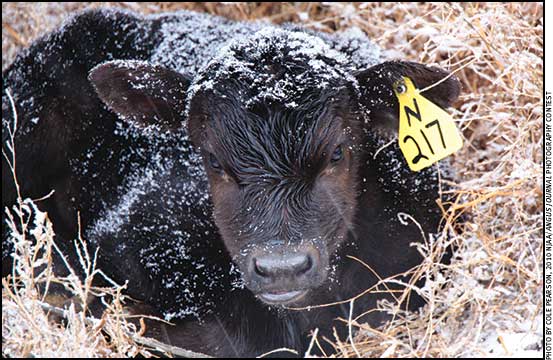MANAGEMENT...

Dealing with Cold Stress in Calves
Baby calves are more vulnerable to cold weather than older cattle and may need special care.
Cold temperatures bring additional challenges when accompanied by wind or wet weather. Russ Daly, Extension veterinarian and associate professor at South Dakota State University, says that even very young calves can handle fairly cold temperatures if they are dry and have the insulating effect of a fluffy hair coat.
It’s also crucial to make sure calves suckle adequate colostrum very soon after birth to have adequate energy to keep warm.
“A calf is born with less than a day’s worth of energy, in the form of brown fat, to burn for body heat. If he doesn’t get colostrum, once that brown fat is gone there is no energy available for the calf to maintain or regulate body heat,” says Daly. Read more.
Use a Calf Puller Properly
When a calf needs help to be born, these tips will ease the process for cow, calf and humans.
Most calves can be pulled by hand after correcting any abnormality of position, but occasionally a mechanical calf puller is needed. It is important to first determine whether the calf can be safely pulled, or if it should be delivered by C-section.
Mark Alley, North Carolina State University College of Veterinary Medicine, says a calf jack is a great tool when used appropriately, but if used incorrectly it can cause severe damage. Don’t apply more force than what two strong men can do, pulling by hand.
Never utilize steady maximum pull. Pull when the cow strains, and stop while she rests. Chain placement is crucial, he adds. The puller puts enough force on a leg to pull joints apart or fracture bones. Put one loop above the fetlock joint and a second loop in a half hitch below it for two points of pull, spreading the pressure so it’s not all in one place — or blood flow may be cut off. Pull slowly and gradually, using lots of lubricant. Read more.

Kris Ringwall
Beef Talk
Feeding calves high-priced hay needs to be a bridge from one low-cost production scenario to the next.
As the year ends, reflecting on the past year is good. The obvious point this year is the lack of forage and how, as producers, one responded to the challenge.
The Dickinson Research Extension Center needs more than 1,000 1,300-pound (lb.) bales to make the stretch to spring grass. That number is buffered a bit because the calves are receiving 3 lb. of commercial supplement daily, and the cows get 4 lb. of commercial supplement every other day. Forage is the essence of a cattle operation, and keeping costs low is critical.
Fortunately, the center’s forage feed needs have been helped by the more recent good weather. We had a moister fall, followed by a kinder start to winter. Cows have done well on crop aftermath, cover crops and standing corn. Still, many producers are short of forage and have had to purchase hay. Read more.
Manage the Risk
CattleFax economist shares tips for managing risk.
Managing risk is different than getting the best price, and a good risk manager recognizes that difference. That was the message CattleFax economist Ethan Oberst impressed upon attendees at the 2017 Range Beef Cow Symposium Nov. 29 in Cheyenne, Wyo.
He encouraged producers to get their risk-management tools in order as the cattle cycle prepares to change.
“High prices are behind us,” he noted. “Profitability has peaked. Margins will narrow, but remain positive [for a time], but that’s going to change.”
No. 1 on his list of recommendations for managing risk is to calculate and know your breakeven. Read more.
New Products
Industry affiliates provide a wide array of products and services to assist you on the farm and ranch. Here’s an assortment of new products to hit the market recently.
Angus Advisor
Click here for February herd management tips from cattle experts across the nation. Advice separated by region.
[Click here to go to the top of the page.]






